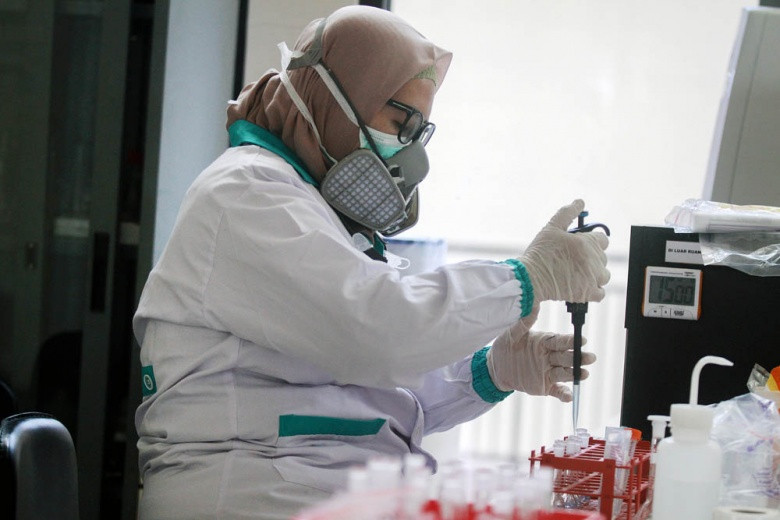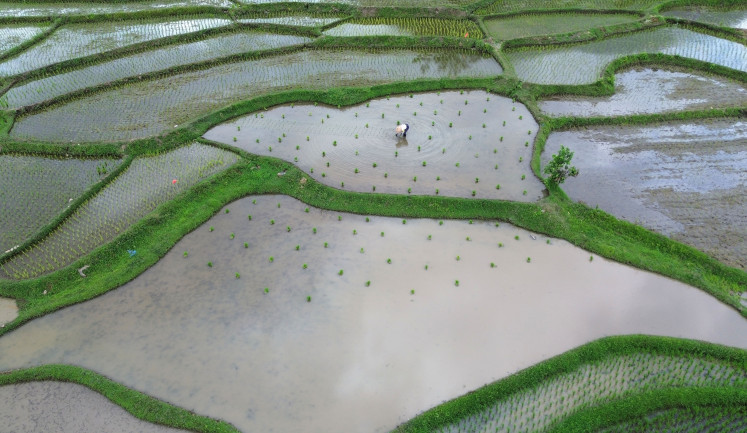Popular Reads
Top Results
Can't find what you're looking for?
View all search resultsPopular Reads
Top Results
Can't find what you're looking for?
View all search resultsWatch out for diseases in poorest areas during pandemics
As health is a fundamental human right, no one should get sick and die just because they are poor or because they cannot access health services.
Change text size
Gift Premium Articles
to Anyone
A
s of Wednesday, according to worldmeters.info, 186,865 people had been infected with the novel coronavirus disease (COVID-19) worldwide with a death toll of 7,471, while 80,836 patients had already recovered. On the same day, Indonesia had 227 confirmed cases with 19 deaths, while 11 patients had recovered.
Unsurprisingly, widespread anxiety persists even as the government frequently reminds us to remain on guard and not panic. However, such efforts will not be effective as long as face masks, hand sanitizer and infrared thermometers remain out of stock or are too expensive in many stores.
Amid the global and domestic focus on the pandemic we still face the threat of tuberculosis (TB), African swine fever (ASF) and dengue.
According to pulmonologist Erlina Burhan of the Indonesian Medical Association (IDI) Task Force for COVID-19, almost 100,000 Indonesians die of TB every year. The latest estimates reveal that 842,000 Indonesians have contracted TB, of which 23,000 have developed a drug resistance to the disease. Almost 75 percent of TB sufferers in Indonesia were of working age as of May 2019, according to the Health Ministry
This data shows that the continued efforts to prevent and combat TB in Indonesia have been ineffective. A lack of data and monitoring of TB patients, the threat of drug-resistant TB and insufficient treatment remain major challenges to dealing with this disease in Indonesia.
Another outbreak is ASF, a deadly animal disease affecting pigs and wild boars with a fatality rate of up to 100 percent.
Data from the United Nation’s Food and Agricultural Organization revealed that as of Feb. 24, 21 regencies and cities had been infected with ASF in North Sumatra, the worst hit province, with 47,330 pig deaths recorded. In Bali, 1,735 pigs died due to unknown causes in seven regencies and cities while 2,825 pigs reportedly died in five regencies and cities due to ASF.
ASF is not categorized as a zoonotic disease, meaning it does not infect humans. Nonetheless, it has devastated local pig farmers. Imagine that if the average farmer typically had 30 to 50 pigs, nowadays he may have only 10 healthy pigs — for which the price has plunged dramatically by around 50 percent per kilogram.
Actually, the ASF outbreak can be handled relatively easily by improving biosecurity in every pig stall, culling infected pigs and clearing out infected stalls for two months. However, the lack of information campaigns about biosecurity measures in affected areas has hampered the response to the disease.
Dengue remains a public health concern as many Indonesians still die of this disease. As of March 15, almost 25,700 dengue cases had been recorded since January across 30 of the country’s 34 provinces with 164 deaths according to the Health Ministry. Of the 3,407 people infected in East Nusa Tenggara (NTT), 39 have died. Other hard-hit provinces include Lampung in southern Sumatra, East Java and Central Java. According to the Health Ministry’s Zoonotic Diseases Prevention and Control Directorate General, dengue prevention measures have been implemented since October 2019. Unfortunately, the government says local governments have not diligently eradicated mosquito larvae, contributing to the current outbreak, mainly in rural areas.
According to The World Health Organization, there is no specific treatment for dengue. Early detection of the disease and access to proper medical care lowers the fatality rate of severe dengue cases to below 1 percent, according to the WHO’s website. Therefore, eradication of mosquito larvae is vital.
The recent dengue outbreak shows the continued lack of attention the government pays to disadvantaged regions and cities. Lampung, NTT and several regencies in East Java, such as Bondowoso, Situbondo, Bangkalan and Sampang, which have the province’s highest incident rates of dengue outbreaks, are categorized as disadvantaged areas based on a 2015 presidential decree.
As health is a fundamental human right, no one should get sick and die just because they are poor or because they cannot access health services.
One solution to deal with zoonosis diseases and the current pandemic is by using the One Health approach — a collaborative, multisectoral and transdisciplinary approach working at the local, regional, national and global levels designed by Calvin Schwabe, widely known as the father of veterinary epidemiology.
Why use the One Health approach? Because zoonosis and pandemic threats cannot be overcome by one sector alone, as they involve all aspects of human health, animal health and the environment.
One example of One Health’s success is when the United States’ Centers for Disease Control and Prevention implemented the approach when people became sick and even died from an infection caused by brown dog ticks in the Rocky Mountains.
Public health and animal health officials used long-lasting tick collars on dogs, regular pesticide applications, community education and provided free insecticide spray and neuter clinics for dogs. After only four months, 99 percent of dogs were tick-free and the number of infected people decreased in the community.
Public health experts, physicians, veterinarians and the community cooperated to address this outbreak. This experience showed that this approach could be used to combat epidemic and pandemic threats. In Indonesia, the utmost challenge today is overcoming simultaneously both the pandemic and other outbreaks in disadvantaged regions. Collaboration across sectors is of course essential to address these threats.
As WHO director general Tedros Adhanom Ghebreysesus said, citing the WHO’s Constitution, “The enjoyment of the highest attainable standard of health is one of the fundamental rights of every human being without distinction of race, religion, political belief, economic or social condition.” Equality is about supporting each other and ensuring no one is left behind.
***
Veterinarian in the School of Veterinary Medicine, Airlangga University, Surabaya, East Java. Founder of the Indonesian One Health Movement, a social movement that focuses on the implementation of the One Health approach to address global health challenges.











